#Rocky Mountain wapiti
Text
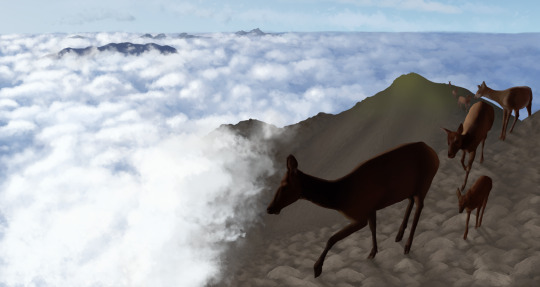
Deercember Day Twenty-Six: Rocky Mountain Elk | Wander
The elk (Cervus canadensis), or wapiti, is the second largest species of deer, and one of the largest terrestrial mammals in its native range of North America and Asia. The word "elk" originally referred to the European variety of the moose, Alces alces, but was transferred to Cervus canadensis by North American colonists. The name "wapiti" derives from a Shawnee and Cree word meaning "white rump" for the distinctive light fur on the animal's rear. The Rocky Mountain elk (Cervus canadensis nelsoni) is a subspecies found in the Rocky Mountains and adjacent ranges of Western North America. It is this subspecies that is found throughout Yellowstone National Park, though many of the animals present are transitory and follow annual migration routes to and from their summer and winter ranges; there are currently between seven and eight herds who intermittently call Yellowstone home, numbering around 30,000 animals total in the summer. The Cody elk herd migrates across rugged country on the eastern side of the Absaroka Mountains near Cody, WY. This large herd of 6,000 - 7,000 animals winters in foothill habitat to the south and west of Cody. There are three core winter areas, with each having a different route back to Yellowstone. In spring, the elk begin their migration, though the elk that winter in the upper Greybull River have perhaps the most arduous journey. From winter range, they climb around 900 meters (nearly 3,000 vertical feet), up and over Needle Mountain, before descending down to the Shoshone River, only to climb again out of the river up to the Thorofare for summer. Some animals in this herd make migrations as far as 188 km (117 mi), while others make shorter migrations; the mean migration length is 93 km (58 mi). More information here and here about the Cody Herd, here about Yellowstone National Park, here about Rocky Mountain elk, and here about elk as a species.
Reference: Deer and Background. (The documentary is great, too!)
#what is sleep#for real though I've been excited about this prompt ever since I saw it and thought of this documentary#elk migration is so perfect for 'wander' to me#finally got to have as many happy little clouds as my heart wanted too#I deeply struggled with those rocks until I settled on just using a brush and I'm glad I did#I've been painting a lot as of late but painting rocks by hand is a bit much for one session for me#I really enjoy this one#I think I've come so far at my backgrounds since day one#I guess I've wandered too.#Deercember#realHum#Art#Drawing#deer#deer art#Rocky Mountain elk#Rocky Mountain wapiti#elk#wapiti#Cervus canadensis nelsoni#Cervus canadensis
2 notes
·
View notes
Video
Rocky Mountain Elk Herd by Elevated Imaging
A happy little harem grazes the valley as the resident Bull watches for would be challengers. Instagram: @elevated.imaging.co Prints & Gifts: 12-christopher-thomas.pixels.com/
#elk#herd#wildlife#nature#wilderness#animals#wapiti#autumn#fall#seasons#Rocky Mountain National Park#colorado#high country#rut#nikon#tamron#flickr#Photography#Autumn Aesthetic#Autumncore#Fall Aesthetic#Autumn Cozy#Fall Blog
19 notes
·
View notes
Text

Here are some photos I took when I went to my trip to Banff, Alberta, like one month ago (yeah, I know)! 🏞️
I originally wanted to carry my Meta & Magolor plushies to the West, but unfortunately, my plane ticket only allowed for one free bag, so I instead opted for the much smaller pipe-cleaner figurines I made about 3-4 years ago!
It was super fun to carry them around while I was hiking and admiring Alberta’s beauty! 🥰
For starters, Banff National Park is the fourth oldest national park in the world, and the oldest in Canada. It has a lot of unique protected fauna, flora and scenery. It’s in Alberta, not too far from Calgary, and it covers the Canadian portion of the Rocky Mountains.
More info-dumping about my trip and more photos (with or without blorbos) under the cut! 👇
This is the view from Sulphur Mountain’s summit. I went to the top thanks to a gondola (because the peak is really high).

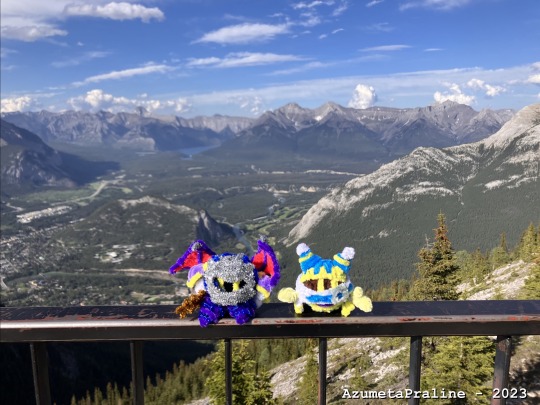
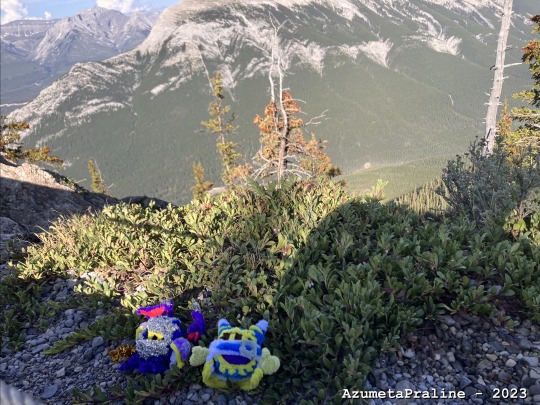
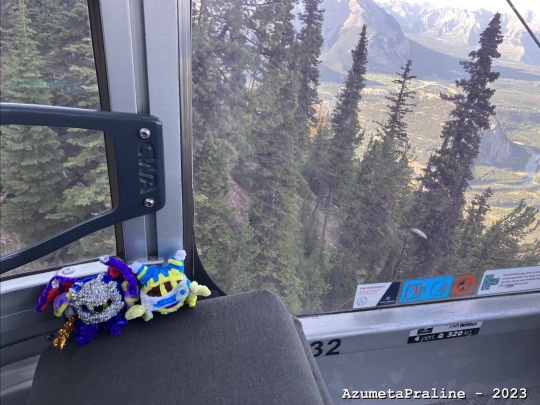
This is Moraine Lake! Probably one of the most beautiful places I’ve seen in my life. Trust me, the actual scenery is much more grandiose than in the photos!


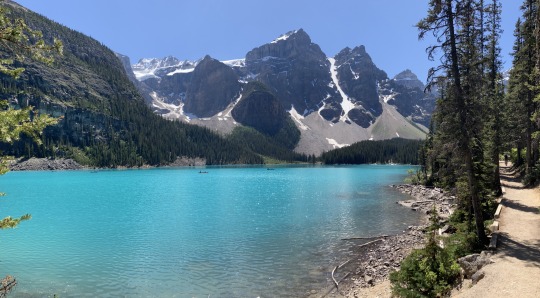
Lake Louise is not too far from there. Although its water’s color isn’t as unique as Moraine Lake’s, it looked absolutely gorgeous.


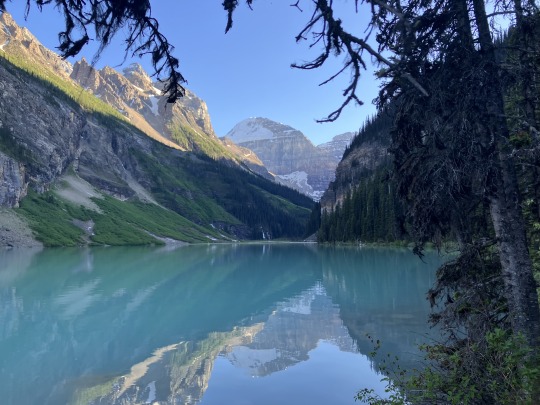
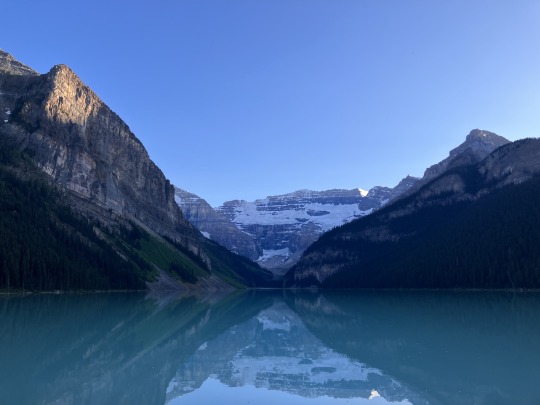
I’ll never forget the view of Lake Minnewanka, or the forests and canyons surrounding it; neither will I forget almost having a heat exhaustion from walking for too long under the sun and running out of water in the middle of the forest. 😅

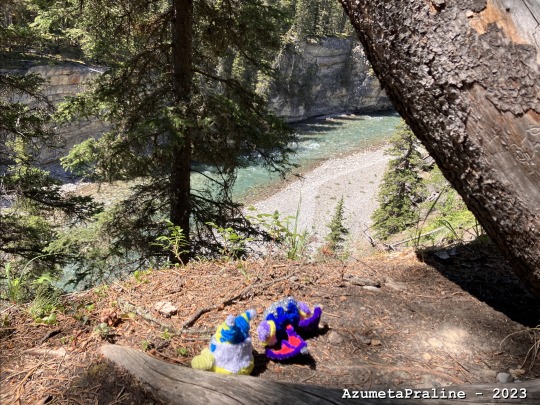

Finally, I present you my absolute favorite place in the park. Moraine Lake is unique, yes, but Johnston Canyon is loterally a corner of paradise; beautifully-arranged trees, rocks and plants, and absolutely gorgeous waterfalls. The droplets felt so refreshing after a long hike! My brother told me that in winter, the waterfalls freeze! What a shame! I’ll be forced to come back there another time… 😩

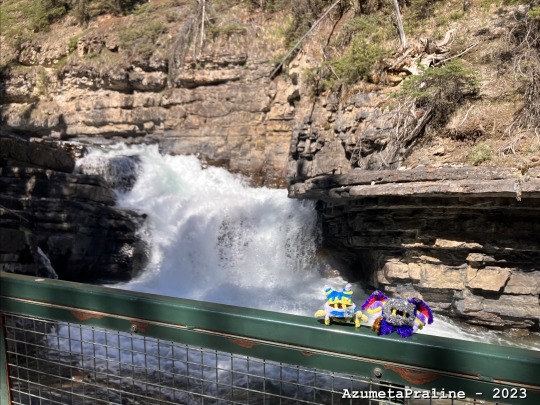
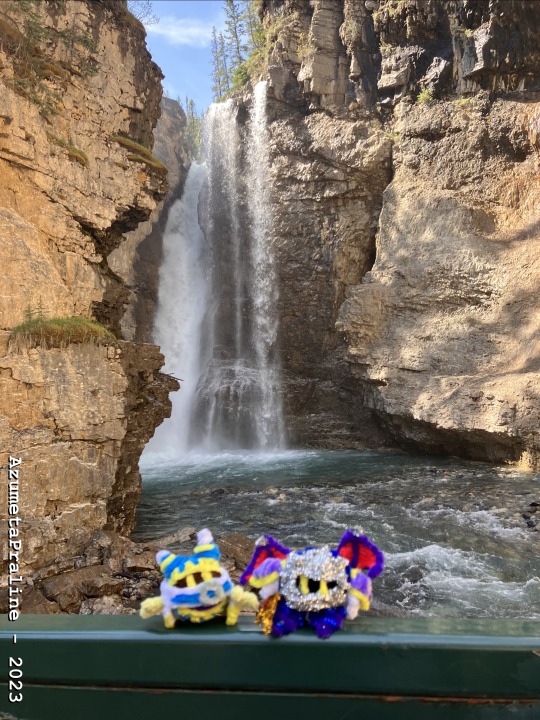
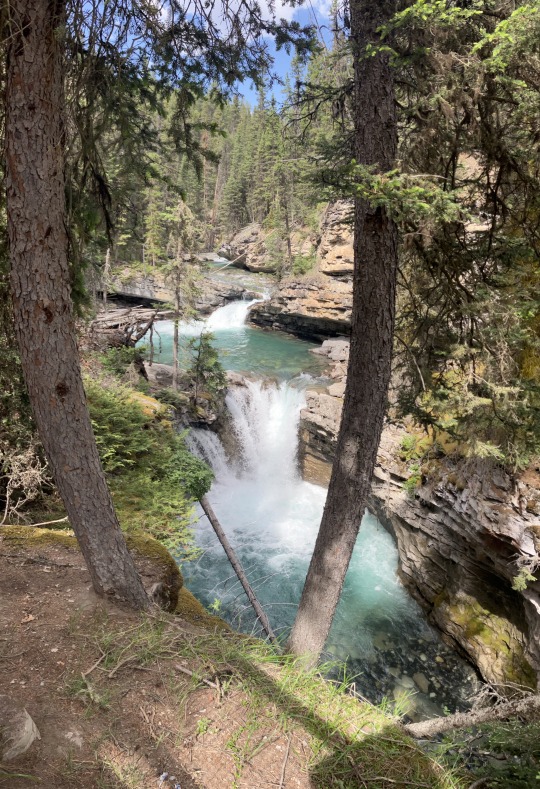
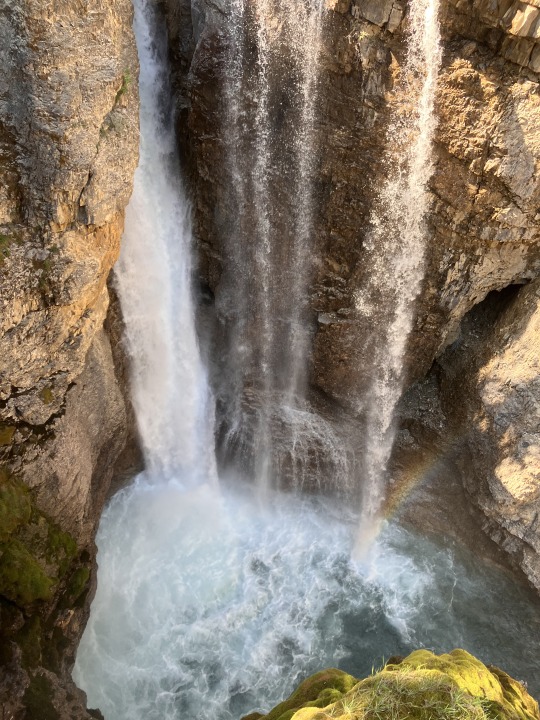
Of course those are just the main places I’ve gone in those five days. There were also a lot of shops, restaurants, a few museums around. My hostel was awesome too, and I’ve explored a trail and ended up in some camping site in which I saw a wapiti. Here are some photos of animals I’ve taken during my trip (starting with the creature):
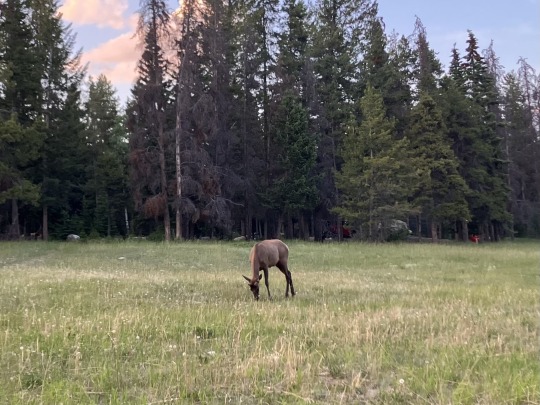


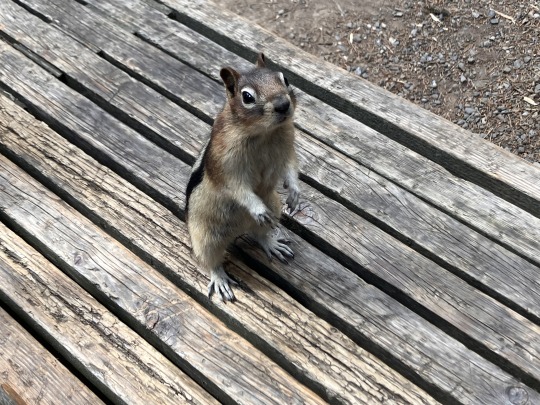
I loved this trip so much! Making this post reminded me of all the nice memories I lived in Banff. I feel lucky for having such an opportunity! It was also the first time of my life in a plane, and I did it alone (it being a domestic flight did help though)! 😄
Thank you so much for reading all this text and looking at my photos! I hope you enjoyed it, feel free to share if you want to. Have an amazing day/night… and a cookie! 🍪
Azu🦋
#banff national park#kirby#meta knight#magolor#lake louise#moraine lake#metalor#johnston canyon#lake minnewanka#azu's plushie photos#did i use my trip to banff as an excuse for metalor propaganda#or did i use my blorbo pictures as an excuse to talk about my trip#even i do not know#i think it's both#both is good… i love both…#metalor fanart
18 notes
·
View notes
Text
Day 10 - 11: Jasper Nationalpark
Der Ausblick aus meinem airbnb-Kellerfenster ist alles andere als grandios 🙄, eine urige Lodge mit Veranda mitten in der Natur wäre mein Traum gewesen, aber leider unerschwinglich.

Zum Glück bin ich ja zum Wandern hier - und davon hat der Jasper Nationalpark in den Rocky Mountains einiges zu bieten. In den ersten zwei Tagen erkunde ich das kleine Städtchen Jasper (erster Eindruck: sehr touristisch, viele Restaurants) und folge lieber den Trampelpfaden durch die angrenzende Wildnis. Mein Radius beschränkt sich dabei auf etwa 10km, da ich kein Auto habe und es keine öffentlichen Verkehrsmittel gibt. Doch ich bin schon nach wenigen Metern begeistert. Während ich entlang des milchig-farbigen Athabasca River spaziere, entdecke ich einen riesigen Elchbullen (Korrektur: Wapitibullen!, wapiti in der Sprache der Shawnee bedeutet "weißes Hinterteil") auf einer Insel im Fluss.


Ich halte das für einen grandiosen Start ins Abenteuer und mache direkt auch ein vorbeiwanderndes Ehepaar aus England auf meinen Fund aufmerksam - werde aber einige Tage später wissen, dass Elche Wapiti die Gegend genauso bewohnen wie bei uns Rehe, oder vielleicht sogar Hauskatzen! Egal, in diesem Moment rechne ich jederzeit damit, gleich hinter der nächsten Biegung einem Bären zu begegnen.
Es zeigen sich jedoch nur Enten, Greifvögel und Eichhörnchen... Ich wandere an den Seen Edith, Annette und Beauvert entlang und erklimme den Old Fort Point.




0 notes
Photo

Rocky Mountain elk (Cervus canadensis nelsoni)
Photo by Adam Kahtava
#id'ing#rocky mountain elk#north american elk#elk#wapiti#cervus canadensis nelsoni#cervus canadensis#cervus#cervini#cervinae#cervidae#ruminantia#pecora#cetruminantia#artiofabula#artiodactyla#scrotifera#laurasiatheria#boreoeutheria#eutheria#mammalia#tetrapoda#vertebrata#chordata
133 notes
·
View notes
Text

Big deer 🦌
So, I see a LOT of elk driving to/from work. Fun thing, even though they're glow in the dark white here, at night, they dont look like elk. They look like headlights coming through the next stand of aspens, til your right on top of them 😬
Between them, and the pitch black, too tall for their eyes to glow in the headlights moose? Yeah, we drive slow in the mountains at night
#art#sketch#quick sketch#white board thoughts#white board#dry erase#deer#deercember#elk#wapiti#rocky mountain elk#cervine#animal art#colorado wildlife
9 notes
·
View notes
Photo

From NatHab/WWF Wildlife Photo of the Day; September 22, 2018:
Elk
Andre Secours
Species: Rocky Mountain Elk (Cervus canadensis nelsoni) | Location: Quebec, Canada
Elk taken in northern Quebec, Canada.
6 notes
·
View notes
Photo

Springtime Elk
A young cow elk I found in Selway Meadows last Spring.
Nikon D7100, Manual Mode, Tamron 150-600mm VC, F/6.3, ISO-1000, ET 1/500, Focal Length 600mm, Hand Held Vibration Control on
#Elk#Wapiti#cow#calf#bull#deer#Wildlife#wildlife photography#wildlife photographer#wildlife art#wildlife photo#wildlife photograph#wildlife photo art#nature#natural light#explore#image#rocky#mountains#Rocky Mountains#Rockies#Beaverhead#Beaverhead-Deerlodge National Forest#photo#photography#photograph#photographer#photography art#photo art#Photos of Southwest Montana
22 notes
·
View notes
Note
It's two-thirty and I should be asleep but I wanted to ask you for more details about moose and elk! If I read those tags right, you said that folks who knew *of* bigass deer in Europe called 'elk,' but had never seen one, came over here, saw a moose, and went "oh that must be an elk," yes? So the terms are inverted here to what they are in Europe? Where do reindeer fit into this? Are they a separate species of bigass cervine? Or is it another name for the same critter? (I could definitely google this, but I wanted to ask you first bc hearing people talk about their interests is fun)
(Also I'm sorry to hit you with a wall of text, I just get long-winded when I'm curious and excited)
Never apologize for big walls of text, they make me happy.
So yes, originally the Europeans who came to and set up settlements in North America were from Western Europe, whereas European elk (to clarify, the animal Americans call moose) only existed in Northern and Eastern Europe, so most settlers in North America had never seen a European elk. So to them, elk were big deer - like red deer, a Western European deer species, but bigger.
Therefore, upon arriving in North America, they very quickly encountered wapiti (North American elk), which currently mostly only exist in the Rocky Mountains but used to occupy most of what’s now the US. These are big deer. Bigger than the red deer they are used to, much bigger than the white-tailed deer of the region, so... these are elk. Obviously. The Very Big Deer.
Moose live - and have always lived - much farther north than wapiti. So by the time European settlers encountered them regularly, they’d already established wapiti as elk in their language. And... yeah, red deer and elk are Big Deer, but they’re still deer shaped. Moose... are certainly taxonomically deer, but looking at them, you know they’re something Different and Older and More Primal. I actually do not know if the first few Europeans who encountered moose even recognized them as something that existed in the Old World - I’ll admit, New World history and especially American history is the area I’m weakest in as a historian because it makes me sad - but at the very least, they already had a New World animal they were calling elk.
So instead of doing the sensible thing, and calling wapiti by their native name, we now have a Very Large Deer that inhabits North America and East Asia that is called elk in North America (and many other names where it exists in Asia, but of course European colonists would not take that into account if they were even aware of it, which they most certainly were not). And we also have an Even Larger Ice Age Remnant Creature that exists... pretty much across the northern subpolar regions of the planet that is called elk in Europe and moose in the Americas, and all of this causes a great deal of confusion all around.
Reindeer also have different names in Europe and the Americas (they’re called caribou in the Americas), and as with wapiti and moose/elk they are the same species across different continents, but at least you don’t have the linguistic confusion of two different species known by the same name. It’s just one species known by multiple names, which is fully reasonable given that different linguistic groups had longstanding relationships with these animals before ever coming into contact with each other.
...boy I hope this explanation made some kind of sense.
65 notes
·
View notes
Photo
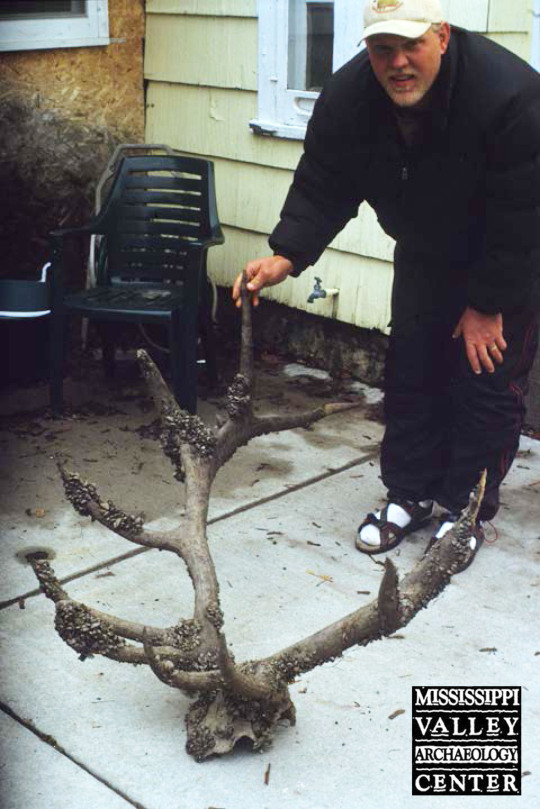
Thanks to Jim Theler for this week’s post –
THE NASACK ELK ANTLERS
In the spring of 2001, Rick Nasack was fishing on the Mississippi River near Winona, Minnesota. When he pulled up his anchor, he thought it had caught on some tree roots, but looking more closely, he saw a set of elk antlers still attached to the top of the skull. The antlers were covered with invasive zebra mussels. The age of the antlers is unknown, but they are almost certainly those of the now extinct eastern elk subspecies, last recorded living in the Wisconsin-Minnesota region about 1870. Antler finds and early historic sightings indicate that elk or “wapiti” were once widespread in Wisconsin (Jackson 1961:410, Map 75). Fragments of elk bones and antlers are found at many Native American archaeological sites in western Wisconsin, but there is no reason to think that these particular antlers are associated with human activity, either ancient or historic. Elk, deer, and bison commonly “went through the ice” and drowned while trying to cross rivers in the winter, and that might be how these antlers ended up in the Mississippi. Presumably they became buried in river sediment and emerged during an erosion episode. The eastern elk subspecies differs from the western Rocky Mountain elk (Thomas and Toweill 1982) that has now been introduced into portions of Wisconsin. Thanks to Rick Nasack’s recognition of their importance, the antlers were saved for others to appreciate. Cleaned of zebra mussels, they are now housed at the Mississippi Valley Archeology Center (MVAC) on the UW-La Crosse campus. They have been displayed yearly at the MVAC annual Artifact Show held in March at the Valley View Mall in La Crosse.
Hartley H. T. Jackson
1961 Mammals of Wisconsin. The University of Wisconsin Press, Madison.
Thomas, Jack Ward and Dale E. Toweill
1982 Elk of North America: Ecology and Management. Wildlife Management Institute, published by Stackpole Books, Harrisburg, PA.
67 notes
·
View notes
Text
Hunting elk in the mountains of Montana is by far one top of the bucketlist hunts in North American Continent. Steep terrain, thick timber, and sweeping views offer many hardcore hunters exactly what they’re looking for – high risk for high reward.
Chasing the Wapiti is not easy – as they seem to disappear and reappear in the alpine forest in the blink of an eye. Despite their large size, with some bulls weighing close to 1000 pounds, these ungulates are ghost of the forest.
One’s first expectation for an animal so large is that they’re easy to find. For the most part, this can be true during the rut and later part of the fall, where the elk migrate and gather in large herds. However, getting one up close and within shooting range of your bow – is a completely different story. Many hunters will find (and learn) quickly that they may see elk in one location one day and by the time they hike out to the last known location – they’re gone.
This is the cat and mouse game of elk hunting – this is the addiction.
One can come out of the elk woods empty-handed, as we did this past weekend, but you will never come out without an experience of a lifetime.
Rest assured, we will be back.
Be sure to check out our team’s contributors Seth Morris and Rick Hutton’s work on Instagram!
@signs_west
@rhuttonjr
Check out our latest blog post! The team heads to Montana for the opener of the elk archery season. Grueling temperatures, wildfire smoke, and silent elk made for a challenging hunt. Chasing the Wapiti is not easy - as they seem to disappear and reappear in the alpine forest in the blink of an eye. Hunting elk in the mountains of Montana is by far one top of the bucketlist hunts in North American Continent.
#backcountry#backcountry hunters and anglers#big game hunting#elk hunting#First Lite#Hunt#hunter#Hunting#hunting gear#landscape photography#montana#photographer#Photography#rocky mountain elk foundation#rocky mountains#wapiti#western hunting#wild#wilderness
1 note
·
View note
Photo

Island Weirdness #58 — Candiacervus ropalophorus
The island of Crete has been isolated since about 5.3 million years ago, when the dried-out Mediterranean Sea refilled — but at that time it started off as several much smaller islands, and only gained its larger modern shape thanks to tectonic uplift in the Pleistocene.
It only had a small number of endemic land mammals during the Pleistocene, whose ancestors all seem to have reached the island by swimming or rafting from southern Greece: dwarf elephants, a small hippo, an otter, a shrew, large mice, and several deer.
Deer are surprisingly good swimmers, and seem to have colonized Crete by the mid-to-late Pleistocene 300,000 years ago. They were by far the most diverse mammals on the island, with eight species in six size classes, each living in different types of habitat and specializing in their own ecological niche in a similar situation to the older Italian Hoplitomeryx. Their anatomy was modified so much that it's unclear what their original ancestors actually were, or even if they were all descended from a single colonization or multiple arrivals, but they seem to have been close relatives of the huge Megaloceros.
All eight species are usually classified in the genus Candiacervus, and the smallest and weirdest of them all was Candiacervus ropalophorus.
Ironically for a cousin of the giant deer it was tiny, just 40-50cm tall at the shoulder (1'4"-1'8"), with proportionally short stocky legs more like a goat. It seems to have convergently evolved to occupy the same niche as wild goats do elsewhere, clambering over steep rocky mountainous terrain and eating tough prickly vegetation.
The antlers of the males were huge for their body size, around 77cm long (2'6"), and they were simplified into a long straight beam with only a single small spike at the base. The far ends were wider and rounded, described as club-like or spatula-like, and their odd shape suggests they probably weren't much use for fighting and wrestling like in other deer. Instead they seem to have been more just for show and visual display.
Meanwhile a second dwarf species, Candiacervus reumeri, had more standard-looking antlers and probably still fought each other.
The largest species, Candiacervus major, was as big as a modern wapiti, with a shoulder height of around 1.65m (5'5") and body proportions much more like a normal long-legged deer. Its antler shape isn't actually known yet, but since it lived in thickly forested areas of Crete the stags may have had more streamlined antlers to avoid getting snagged on low branches.

The various Candiacervus species went extinct towards the end of the Pleistocene, around the start of the Last Glacial Maximum 21,500 years ago. Originally this was thought to be long before humans ever reached the island, but more recent discoveries have brought that into question.
Humans do actually seem to have encountered living Candiacervus ropalophorus, since petroglyphs in Asphendou Cave appear to depict the dwarf deer and so must be at least 21,500 years old. Additionally, even older stone tools on the southern coast of Crete from at least 130,000 years ago match those made by archaic humans (probably Homo erectus) who may have arrived over sea from northern Africa.
So it's possible the weird Cretan deer survived alongside humans for some time, but then their habitat started to degrade as the climate shifted rapidly colder and drier. Some remains show that many individuals were suffering from secondary hyperparathyroidism and metabolic bone disease, signs of severe nutritional deficiencies, and their weakening population may have ultimately been unable to deal with both the malnutrition and the additional pressures of human hunting.
#science illustration#island weirdness 2019#paleontology#paleoart#palaeoblr#candiacervus#cervidae#deer#artiodactyla#ungulate#mammal#art#crete#mediterranean#insular dwarfism#quaternary extinction#island weirdness 2: endemic boogaloo
206 notes
·
View notes
Photo

Montana by Suzanne Phillips
http://hoof-and-paw.blogspot.com/
2 notes
·
View notes
Photo



Elk or Wapiti are some of the largest species of deer in North America, rivaled only by the Moose. During the winter months, Elk pair off into same-sex groups to survive the harsh conditions and protect themselves from predation.
FIND MORE PHOTOGRAPHY HERE
INSTAGRAM
This Bull Elk (male) was a part of a group of five that descended from the mountains early in the morning to search through the snow for vegetation to consume.
Inspiration: Scenes from an Italian Restaurant - Billy Joel
Taken: Rocky Mountain National Park, Colorado 12-15-19 747AM
Nikon D7200 200-500mm f/5.6
#rocky mountains#rocky mountain wildlife#wild#wildlife#wilderness#nature#nature photography#wilderness photography#wildlife photography#elk#elk photography#bull elk#winter#cold#snow#photography#natgeo#national geographic#nikon
45 notes
·
View notes
Text
Get Best Vacation Homes for Rent in Cody, Wyoming
Wapiti Valley Vacation Rentals brings for you best vacation homes for rent in Cody, Wyoming. Wapiti Valley Vacation Rentals is nestled in the Absaroka Mountains on the northern end of the Rocky Mountains located halfway between Cody.
1 note
·
View note
Photo

Rocky Mountain elk (Cervus canadensis nelsoni)
Photo by Jon Atkinson
#rocky mountain elk#north american elk#elk#wapiti#cervus canadensis nelsoni#cervus canadensis#cervus#cervini#cervinae#cervidae#ruminantia#pecora#cetruminantia#artiofabula#artiodactyla#scrotifera#laurasiatheria#boreoeutheria#eutheria#mammalia#tetrapoda#vertebrata#chordata
13 notes
·
View notes
